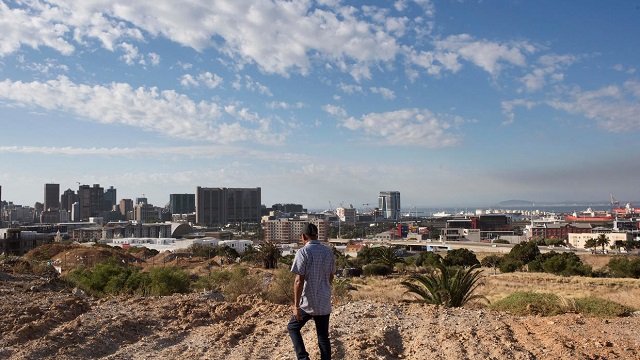
Cape Town, South Africa | AFP | “It was just here. My house was number 41 Clifton Street,” said Cassiem Morris, his voice catching as he points to where his Cape Town home was razed to enforce apartheid.
Morris, a South African of Malay origin, took his first baby steps 56 years ago in the house in District 6, then a multiracial neighbourhood of the coastal city.
South Africa’s white minority government in 1966 listed District 6 as a “white” area under its racial segregation policy. Most residents were forcibly moved because they were black or mixed-race and bulldozers destroyed their homes.
A quarter of a century after the fall of apartheid, this page in South Africa’s dark history may have turned. But a court decision has raised hopes of returning home for the dispossessed people of District 6.
“Whatever the colour of your skin and whatever you believed in, we were a big family of almost 50,000 people,” Morris said. “That was the amazing part because there was never a problem.
“It is sad, it is extremely sad.”
Scant trace remains of the little streets that crisscrossed at the foot of Table Mountain. Only a handful of churches and mosques were left standing when the area was cleared.
– ‘A blot cleaned up’ –
Though he was a child, Cassiem Morris has never forgotten the expulsions of February 11, 1966 under the Group Areas Act that assigned different racial groups to separate areas.
“I can still see the day where the Group Areas Act people went to my grandfather and told him that he has to move. He said ‘You can literally demolish everything around me, I will wait until my time comes to move’.”
The head of the household held out for four years before being driven away.
“When we returned just to come and see the place one or two days later, the whole house was flattened already,” Morris said.
Future head of state P.W. Botha, then minister for community development and coloured affairs overseeing segregation, praised the operation, calling District 6 a “blot” that needed cleaning up.
All non-white residents were forcibly displaced to Cape Town’s distant shanty townships.
“At that time, we coloured people were treated like nothing,” said Salie Davis, who described eviction as “traumatic”.
“We had to leave in such a hurry. We had to leave so many things behind and move to an area we didn’t know nothing about, to live in a jungle,” Davis, 59, said.
His family wound up in Hanover Park, more than 20 kilometres (12 miles) away. Retired, he lives in a small apartment in a crowded neighbourhood overrun by crime and drugs.
“There was a better life back then in District 6,” Davis said, adding that people are “determined to move back to their land.”
The fight to return began with the end of white minority rule and the arrival of democracy under the late president Nelson Mandela in 1994, with a brand-new constitution.
When the District 6 dispossessed mark their evictions on Tuesday, the country will also be commemorating the 30th anniversary of Mandela’s release from jail on February 11, 1990.
– ‘Very inept government’ –
A law passed that year was intended to provide restitution of rights in land to people or communities dispossessed because of past racially discriminatory laws or practices.
Former residents of District 6 hoped for a swift return, but it took a decade for the first ones to be resettled in 2004. Even today, only a few hundred people have been reinstalled.
“I don’t think that they had any idea or clue on how to handle restitution,” said Shaheed Ajad, the District 6 Working Committee chairman.
“Most of all, although there was money, the money was squandered. In a nutshell I would say we had a very inept government for 24 years,” the 62-year-old official told AFP.
Running out of patience, Ajad and about 1,000 other former residents of District 6 turned to the legal system two years ago. To widespread surprise, a judge last December ordered the government to take action.
The authorities swiftly presented a proposal for 954 new homes and the resettlement of the plaintiffs and their families by 2024.
Approached by AFP, Land Reform Minister Thokozile Didiza did not respond, but her services stated that a rebuilt District 6 “should be as close as possible to the urban environment from which they were so unjustly removed, within the constraints of available funding and the exigencies of contemporary lifestyles.”
Cape Town, the stronghold of the opposition Democratic Alliance, could give District 6 “a look of the new century”, declared the city councillor handling the matter, Alderman Marian Nieuwoudt.
“This is not the time to play political games. I’m determined to make sure that they all come back,” she said.
Renamed “Sonneblom” (“Sunflower” in Afrikaans) under apartheid, District 6 has seen its original name restored to road signs and Nieuwoudt hopes that building work will start “in the next month or two”.
“We have suffered enough, we now only want what is rightfully ours,” Ajad said. “We need to heal and… come back to the land that we love.”
It may prove an example in South Africa, split over a constitutional reform that would enable the expropriation without compensation of land held by the white minority to benefit the black majority.
“We believe that this small enclave that we call District 6, where life started for many of our forefathers, whether they were white, black or brown, this is where transformation and change can come in South Africa,” Ajad said.
 The Independent Uganda: You get the Truth we Pay the Price
The Independent Uganda: You get the Truth we Pay the Price



